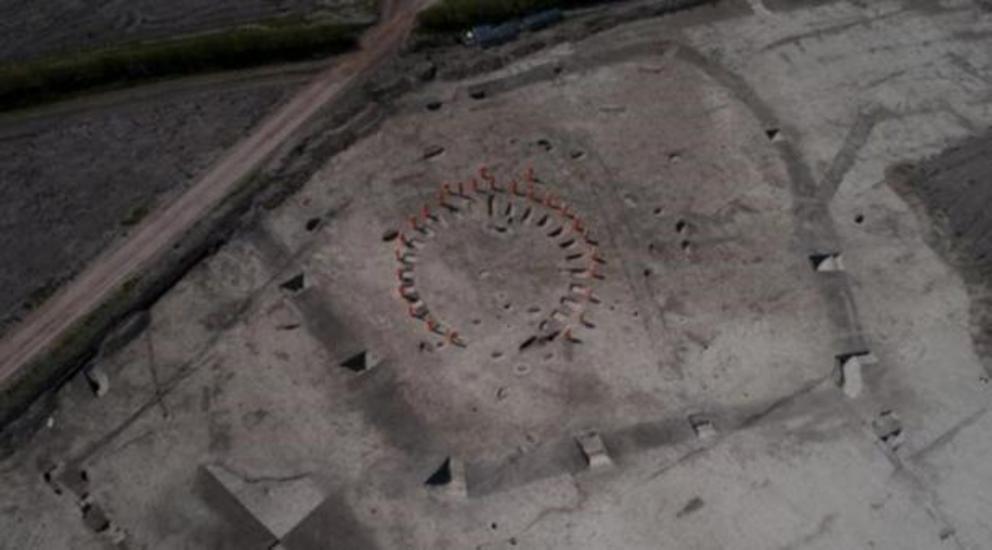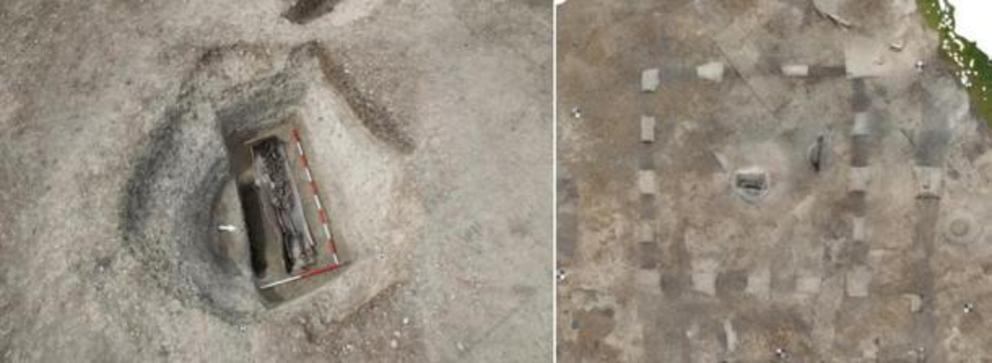Iron age murder victim discovered at ceremonial monument
Skeletal evidence of an Iron Age murder victim has been found while excavating an archaeological site at Wellwick Farm near Wendover. Gold coin found at the site.
Archaeologists in England have discovered evidence of a large ceremonial structure and a potentially brutal human sacrifice. While excavating a 4000-year-old Iron Age site at Wellwick Farm near Wendover, England, as part of the High Speed 2 (HS2) project (the biggest rail project in Europe’s history), archaeologists have discovered the skeleton of a man, who was buried face down, with his hands bound together beneath his pelvis, thought to be the remains of an Iron Age murder victim .
 Skeleton of an Iron Age murder victim has been found while excavating an archaeological site at Wellwick Farm near Wendover.
Skeleton of an Iron Age murder victim has been found while excavating an archaeological site at Wellwick Farm near Wendover.
According to a BBC report, this unique burial was found with further archaeological evidence of human activity ranging from the Neolithic to the Medieval period. Nevertheless, Dr. Rachel Wood explains that the circumstances surrounding the Wellwick Farm man’s death remain a mystery. “There aren ’t many ways you end up in a bottom of a ditch, face down, with your hands bound,” added Dr. Wood, who hopes a team of osteologists will now “be able to shed more light on this potentially gruesome death.”
 The archaeologists also found an Iron Age funerary monument, which would have been used only by high status people.
The archaeologists also found an Iron Age funerary monument, which would have been used only by high status people.
Could Wellwick Farm Be an Archaeoastronomical Site?
Archaeologists believe that during the Bronze and Iron Ages the area around Wellwick Farm hosted increasing domestic occupation which is evident in the discovery of a roundhouse equipped with animal pens and pits for discarded food. During the Roman period this early occupation is thought to have shifted focus to the current location of Wendover, but the Wellwick Farm site continued to be used for burials.
 The team also discovered jewelry, such as this ring, which could date back to the Iron Age.
The team also discovered jewelry, such as this ring, which could date back to the Iron Age.
Hertiage Daily reports that besides finding the Iron Age murder victims’ remains, archaeologists working at the site also discovered a large square enclosure containing a lead-lined wooden coffin with a skeleton inside. This is believed to have belonged to a high-status individual, as they would have needed sufficient surplus income to have financed what was a relatively expensive burial.
 The remains of a Roman burial were found in a square enclosure. The skeleton was located in a coffin lined with lead and what was once a wooden outer layer.
The remains of a Roman burial were found in a square enclosure. The skeleton was located in a coffin lined with lead and what was once a wooden outer layer.
The team of archaeologists also uncovered structural evidence of a 65 meter (213 ft) diameter ceremonial circle of wooden posts, similar to the timber site at Woodhenge in Salisbury Plain . The remains found at Wellwick Farm were also aligned and orientated with the rising and setting winter solstice sun, indicating the presence of ancient astronomical and geometrical knowledge which today is studied using the disciplines and principals of archaeoastronomy.
 Archaeologists excavating the area around Wellwick farm have also uncovered a 65-meter (213 ft) diameter Neolithic ceremonial circle of wooden posts dating to between 4,000 to 5,000 years old, which is evidence of the ritual importance of the site.
Archaeologists excavating the area around Wellwick farm have also uncovered a 65-meter (213 ft) diameter Neolithic ceremonial circle of wooden posts dating to between 4,000 to 5,000 years old, which is evidence of the ritual importance of the site.
Construction of Rail Project Seen as Archaeological Opportunity
A report published by the Media Centre at HS2 quotes Dr. Rachel Wood as saying: “The large wooden ceremonial structure, the Roman lead burial and the mystery of the skeleton at Wellwick Farm helps bring alive the fact that people lived, worked and died in this area long before we came along.”
Mike Court, HS2 Lead Archaeologist, explains that before the low-carbon high-speed railway between London and Birmingham is built, the archaeologists will uncover “a wealth of archaeology that will enrich our cultural heritage.” Court views the enormous construction project as an archaeological opportunity: “The sheer scale of possible discoveries, and the geographical span and the vast range of our history to be unearthed makes HS2 ’s archaeology programme a unique opportunity to tell the story of Buckinghamshire and Britain.”
Get Down and Dig: Getting the Public Involved in Archaeology at Home
The announcement of these discoveries has coincided with the beginning of the Festival of British Archaeology which takes place over nine days between the 11th and 19th July 2020. HS2 is hosting digital events showcasing recent archaeological discoveries intended to help people explore archaeology from home. Events include A Day in Archaeology , Ask an Archaeologist Day and the Shout Out Loud project, all of which aim to get the public interacting with creative online archaeology. Children can join Megan of Barnsley Digs to open an official archaeological dig in their garden or backyard.
Perhaps the most interesting aspect of the Festival of British Archaeology is “ A day in the life of… A fieldwork technician” . Hosted by Wessex Archaeology, the event offers an experiential insight into the day-to-day lives of the organization’s machine drivers and archaeologists, who help strip archaeological sites of their top and subsoil levels so that key areas can be identified and explored. All these fascinating discoveries, and more, will soon be featured in a forthcoming BBC documentary.

